Power BI is widely used for reporting and analytics, but one common question is: Can Power BI send emails? The short answer is… YES!
In this blog, I will take you through all the methods available for sending emails by Power BI.
What do we mean by send emails?
Let’s make sure we are aligned. When we talk about sending emails in Power BI, the first thing that may come to mind is the ability to send a report to ourselves or a list of recipients.
Most think of subscriptions, so scheduling a report to land in an inbox and yes, Power BI does have that. This builds on what many would remember from SQL Server Reporting Services (SSRS) days. Off topic, but I spent a few years of my career fully immersed in SSRS, which was great fun. Sadly, those good memories come bundled with MDX - those who know, know what I mean! Back to it, we also have Paginated Report subscriptions, which are essentially the modern version of SSRS, letting us build operational, PDF-ready reports for email delivery.
But sending emails in Power BI is not just about subscriptions, but also about alerting. Sometimes you do not want a scheduled report but need to be notified when something important happens in the data and that’s where alerts come in.
So when we say "send emails" in Power BI, we could be talking about both:
- Subscriptions: scheduled reports sent by email.
- Alerts: data-driven triggers that notify you when something changes by email.
Summary of Subscription and Alerting Options in Power BI
Before we dive deeper, here is a summary of some of the ways Power BI can send emails, whether as part of a subscription or an alert.
1. Standard Subscription: Schedule and send a view of a report, report page or dashboard to yourself or others.
- Send a single-page preview.
- Attach reports as PPT or PDF (requires PPU or Fabric SKU).
- Set your preferred time zone for scheduling.
- AI-generated summary powered by Copilot (requires Fabric SKU).
- Send reports to OneDrive or SharePoint while still receiving an email notification (requires PPU or Fabric SKU).
- For dashboard, only a preview and access link are included from above.
- Available for Power BI and Power BI Paginated Reports
2. Dynamic Per Recipient Subscriptions: If you are familiar with SSRS, this feature is similar to data-driven subscriptions. It allows you to schedule and send customised reports dynamically per recipient.
- Send personalized reports to each recipient
- Choose a dynamic file format (e.g., PDF, PPT)
- Use a single subscription to distribute tailored report views
- Ensure recipients see only relevant data
- Not available with Power BI Pro, requires PPU, Microsoft Fabric Trial or Fabric capacity
- Available for Power BI and Power BI Paginated Reports
3. Data Alerts on Dashboard Tiles: I was never satisfied with alerts in Power BI, but now Data Activator which we will get to further below. For now, Power BI allows us to set alerts on dashboard tiles, triggering an email when a value hits a target or some threshold.
- Trigger an email when a value in a Card, KPI or Gauge visual exceeds or falls below a set threshold.
- Alerts are private to the user who sets them, only they receive an email.
- Email contains just a notification and a link to the dashboard.
- Cannot be shared or assigned to other users automatically.
- Only works in Power BI dashboards, not reports.
4. Power BI Metrics (Scorecards) Notifications: Power BI Scorecards allow organisations to track business goals and notifications ensure stakeholders stay updated on progress. I have to be honest, until now not seen this used much. However, still relevant to this article as you can set subscriptions on them.
- Send scorecards through email.
- Schedule email frequency hourly, daily, weekly or monthly.
- Emails received can include a table of up to 50 metrics.
- Recipients need a Pro, PPU or Fabric capacity to receive subscriptions.
5. Power Automate-Driven Emails from Power BI: Power Automate extends Power BI’s email capabilities by allowing automated, event-driven emails beyond standard subscriptions. With Power Automate, you can create custom workflows to trigger emails based on data alerts, user actions or external events. I will add, it's been a while since I have used Power Automate for sending emails, and if you can use subscriptions which are ready to be used, do that.
- Power Automate offers templates to send automated emails.
- Trigger emails dynamically based on Power BI actions such as data alerts, button clicks, etc.
- Customise email content with dynamic values, conditional formatting and rich HTML.
- Send emails to multiple recipients, including external users and distribution lists.
- Integrate with other applications such as Outlook, Teams, SharePoint or CRM systems.
- Embed a "Send Email" button directly in a report to allow users to trigger emails manually when needed.
6. Data Activator: Data Activator is a "new" tool as part of MS Fabric that offers a no-code experience that automates actions when data changes in real time. Unlike traditional Power BI alerts or scheduled subscriptions, Data Activator actively listens for patterns or thresholds in Power BI reports and event streams, triggering immediate emails, notifications or workflows.
- Data Activator goes beyond the basic Alerts that I mentioned above for dashboards.
- Data Activator also works for reports, not to be confused with dashboards.
- Monitors live data streams, detects when condition is met such as a sensor exceeding a threshold.
- Triggers automated email notifications instantly, ensuring users are alerted in real time.
- Works beyond Power BI as integrates within Microsoft Fabric.
- Supports complex rule-based triggers, allowing for advanced event-driven automation.
- Can integrate with Power Automate, extending its capabilities to trigger workflows based on real-time conditions.
- Requires a Microsoft Fabric capacity.
Note: There are also third-partytools that can be used and which I have used in the past. However, as of now Ifeel like a lot of the missing features have been brought to Power BI.
By now, you should have a good understanding of howPower BI can send emails or alerts. Now, let’s dive deeper into some of theoptions. However, from the six I shared above, I’ll be leaving out PowerAutomate and Power BI Metrics (Scorecards) for now.
We will be using the below solution to showcases thevarious options we have:
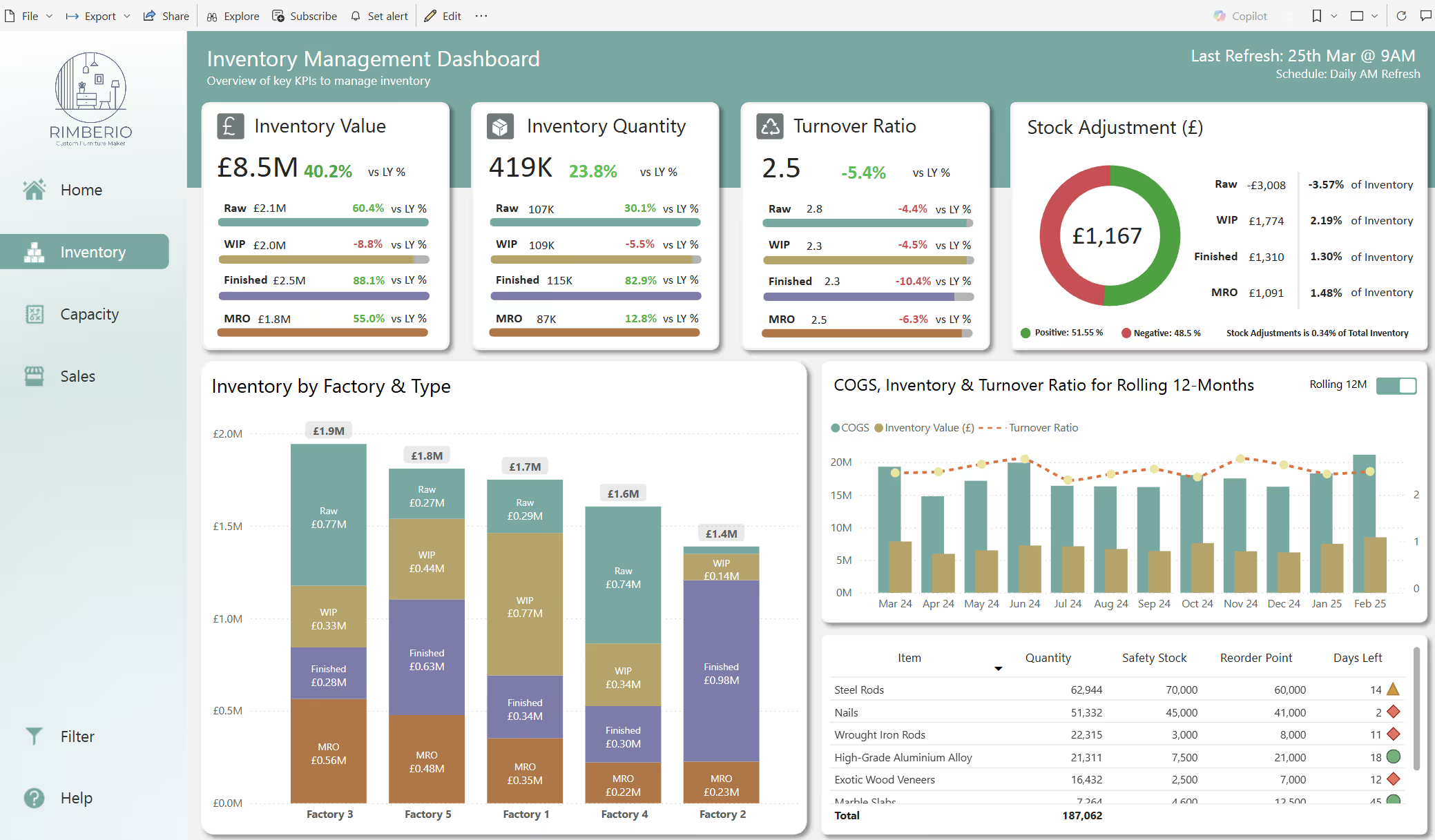
Standard Subscription:
As mentioned, these are the standard subscriptions in Power BI that we’ve always had. In a Power BI report, you can go to the top panel, select "Subscribe," and you’ll be presented with two options, as shown below:
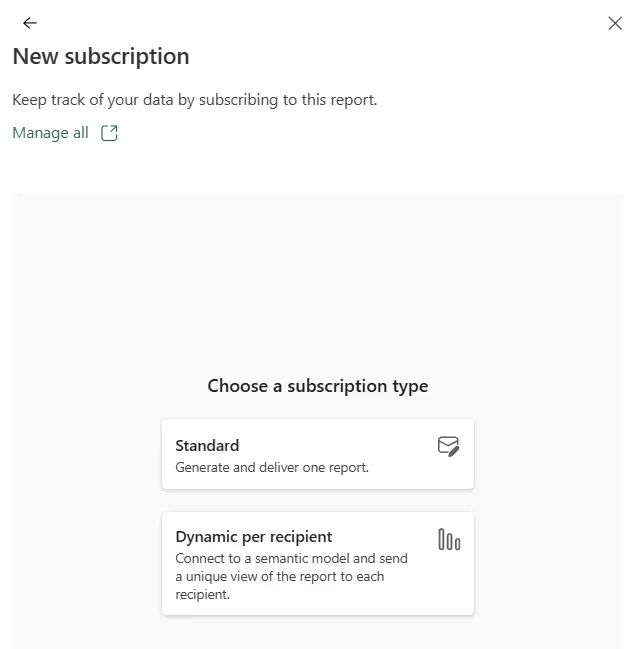
For now, we’ll go ahead and select "Standard," and we’ll revisit dynamic subscriptions later. Once you click "Standard," the following screen will appear, where we can configure the subscription:
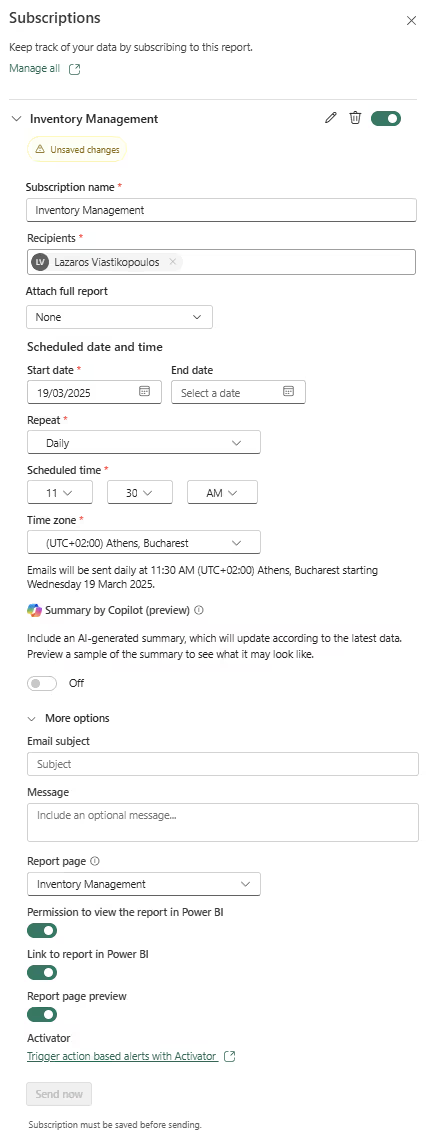
As you’d expect, we can go ahead and add a subscription name, which automatically picks up the name of the report page. We can add recipients which in the example above, I only have myself, but it's worth considering adding relevant security groups.
We also have the option to select "Attach full report." But what does this actually mean? By default, the subscription only sends a snapshot of the report page, embedding it into the email body. Recipients also get a link to access the report directly, which can be enabled or disabled under "Link to report in Power BI" (as seen in the screenshot).
Now, something that catches people by surprise, if you want to attach the full report as a PDF or PPT, you must have at least a PPU license.
Naturally, we can set the start and end date, as well as choose a frequency: Hourly, Daily, Weekly, Monthly and After data refresh. A quick note on "After data refresh"… this is commonly used when organisations want a report to be emailed only after the semantic model (formerly the dataset) has been refreshed. However, it’s only triggered once per day. So, if your semantic model refreshes eight times per day, the subscription will only send an email after the first refresh of the day.
One very cool feature is "Summary by Copilot (preview)." What does it do? Well, it includes an AI-generated summary that updates automatically based on the latest data. To use this, I believe you’ll need a Fabric SKU F64 or higher, as with any Copilot features.
We can also set the time zone, which might seem basic but is pretty important for ensuring reports go out at the right time. Finally, we can configure the email subject and message, which will appear in the email body, along with a few additional toggle options to fine-tune the setup.
Dynamic Per Recipient Subscriptions
Now that we've covered standard subscriptions, let’s take a look at Dynamic Per Recipient subscriptions. The process is pretty similar. We’ll go back to the same report and select "Subscribe" just like before. But this time, instead of choosing Standard, we’ll select "Dynamic per recipient" to see how it works.

We are now presented with the "New Dynamic Subscription" prompt, which I quite like. It has a nice step-by-step flow on the left, guiding us through the process of setting up the subscription.
The first step is "Connect to recipient data". This refers to the semantic model that contains key recipient details, like email addresses, which are essential for making this work. As we go through the setup, we’ll see that we can also make other elements dynamic, such as: The file type (PDF or PPT), email title and report filters. If we want to take full advantage of Dynamic Subscriptions, these elements should be included as part of the semantic model.
So, on the below I’ll go ahead and select the same semantic model used for the Inventory and Capacity Report. However, it's worth mentioning that you can actually choose a different semantic model that contains relevant mapping tables between employees and other attributes for Dynamic Subscriptions. I thought this was pretty cool because my initial assumption was that the subscription model had to be the same as the report’s data model, but that’s not the case! You can select a separate semantic model, allowing for more flexibility, including Dynamic Row-Level Security (RLS).

We now come to "Select and filter data," where we choose the data to map to the subscription’s dynamic fields. In the screenshot below, I’m only using email addresses, but you could also bring in other dynamic elements such as the email subject, attachment file type (PDF, PPT) and report filters, allowing for a more customised and automated subscription experience.
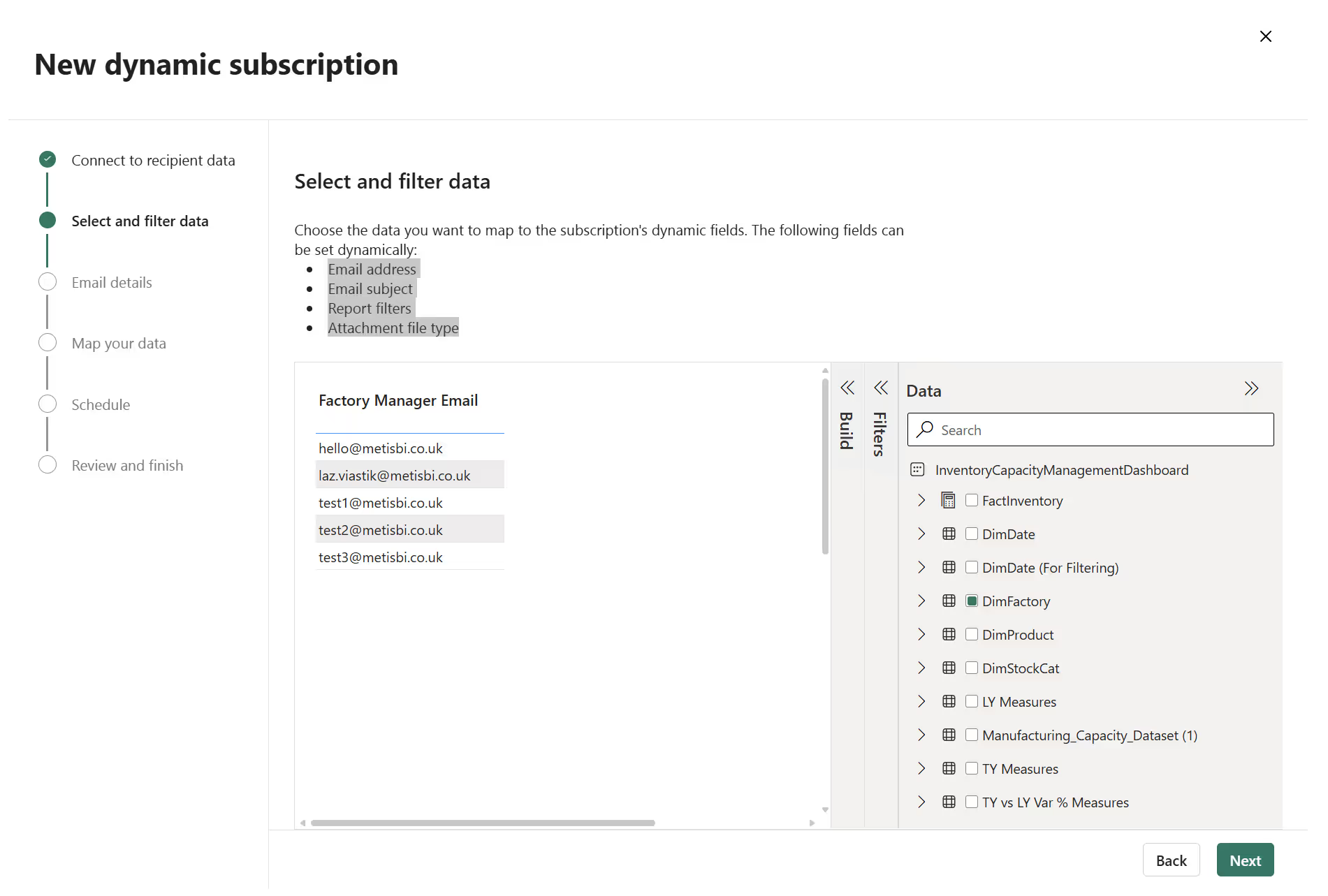
We now come to "Email details" where we can see all the elements that are dynamic. For example, under recipients, instead of manually entering addresses, switch to "Get from data," and the columns selected in the previous step will appear here. In my case, I can see the Factory Manager's Email. Similarly, just as we selected "Get from data" for recipients, we can do the same for email subject, report page and attaching the full report.
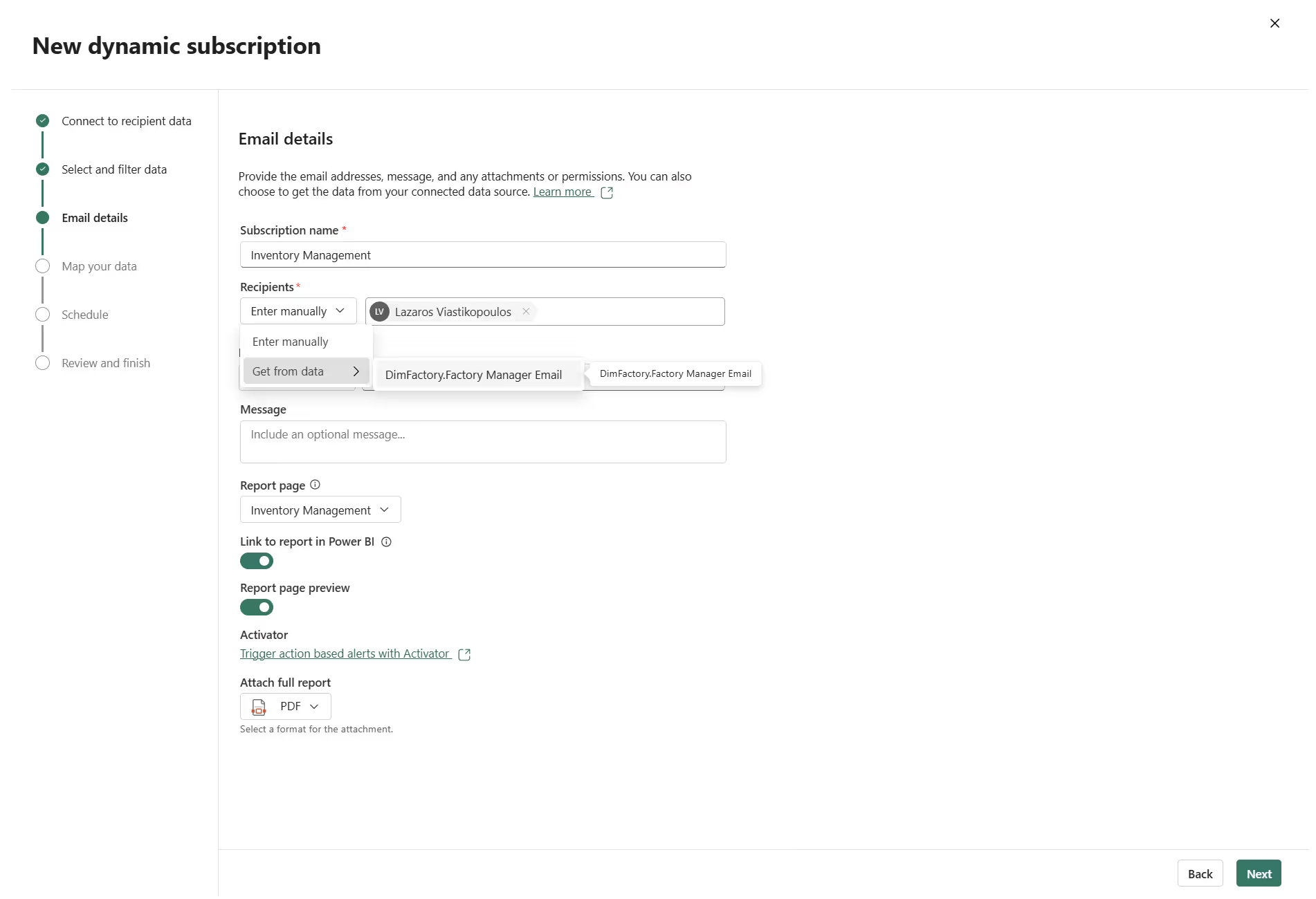
We then move to "Map your data," which is quite self-explanatory. This step defines the filters applied to the report sent in the subscription, ensuring each recipient receives only the relevant data.
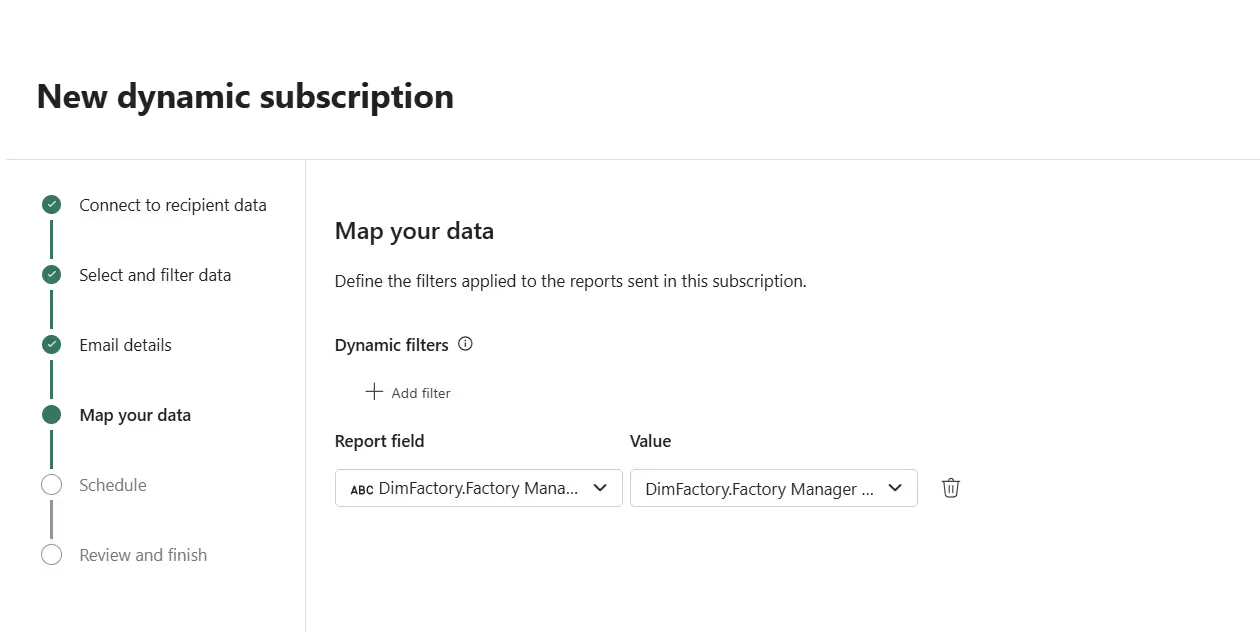
We then get to the "Schedule" section, where we select the start/end date, recurrence, time, and time zone for the subscription.

To finish up, we "Review and finish" as per the below screenshot:
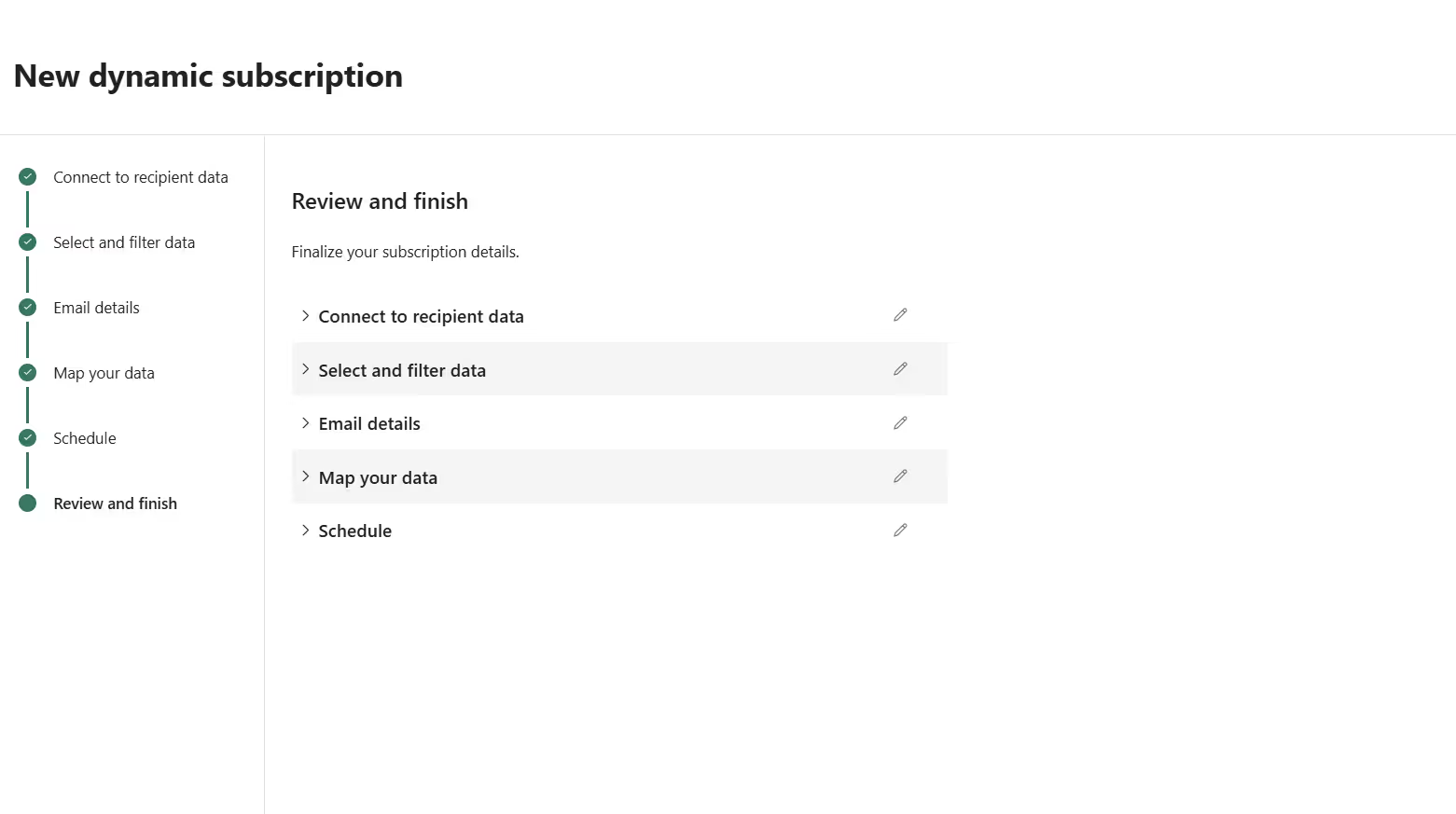
To finish up, for this to work, it must be backed by a Fabric capacity or a MS Fabric Trial. Additionally, you need build permission to the semantic model that contains the recipient data. Lastly, you must be a member, contributor, or admin in the workspace.
Data Alerts on Dashboard Tiles
We now arrive at my all-time favourite feature of Power BI Alerts… NOT! I’ve always felt these missed the mark. Why? Well, they’re only available in dashboards (Microsoft's definition of a dashboard), which… let’s be honest… not many people use! So, from the original report we’ve been using in this blog, I pinned two visuals as tiles to a dashboard. Below is the result:
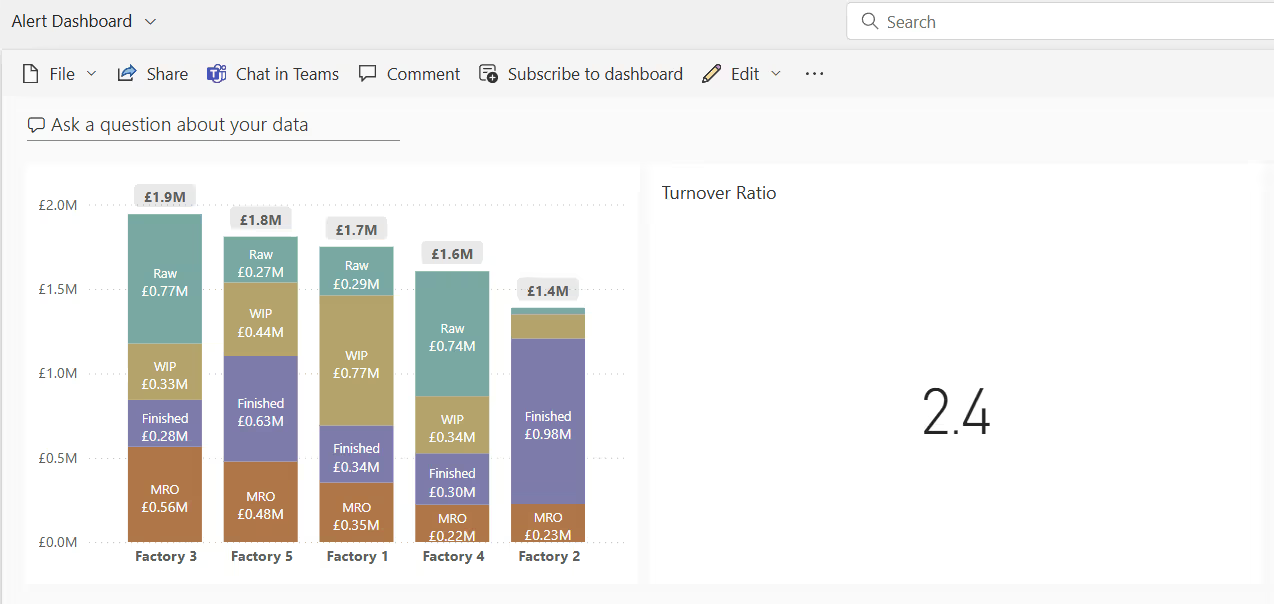
I will now hover over the card visual and select "Manage alerts" as shown in the screenshot below. Also, keep in mind that alerts can only be used in dashboards and only for Card, Gauge and KPI visuals. Nothing else!
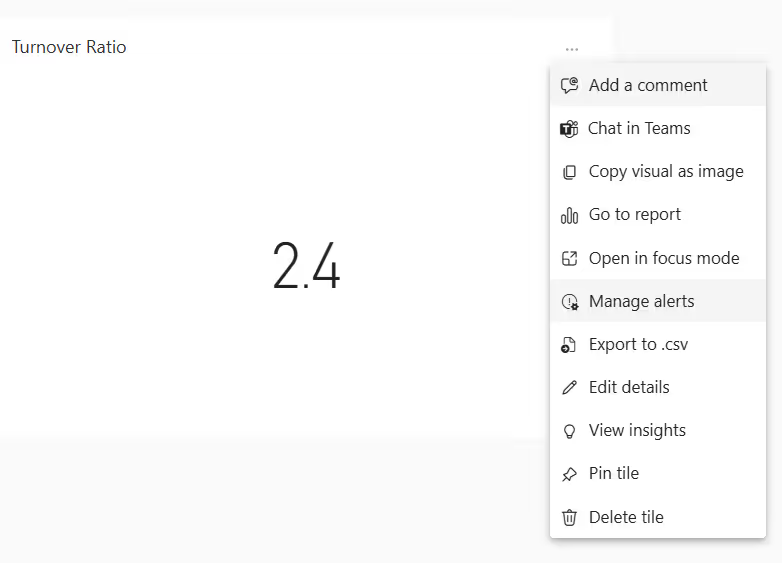
Notice that you can also receive an email if you select the checkbox below. That’s pretty much it, I won’t go into more details. However, there are a few things to be aware of. Alerts aren’t supported for card tiles with date or time measures, they only work with numeric data types and they only trigger on refreshed data, not static values. Also, since alerts are only sent when your data changes, you won’t receive duplicate alerts for the same unchanged value.
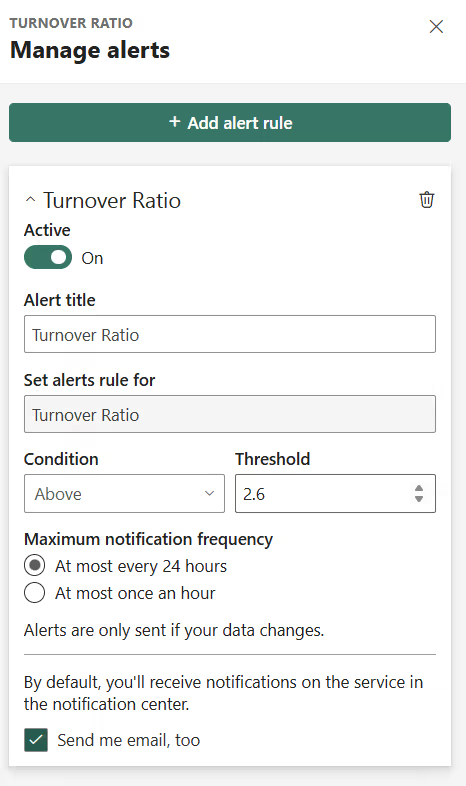
Data Activator
So, we arrive to the final option we will be exploring in this blog which is Data Activator. Please keep in mind, this is not a deep dive for Activator by any means. I am purely going to focus on the emailing and alerting elements which are relavant to Power BI.
With that said, let’s walk through the process step by step, using the "Units Assembled" measure as an example. Do note, this is a Power BI report, not dashboard. So, already better then the Alerts we explored above.
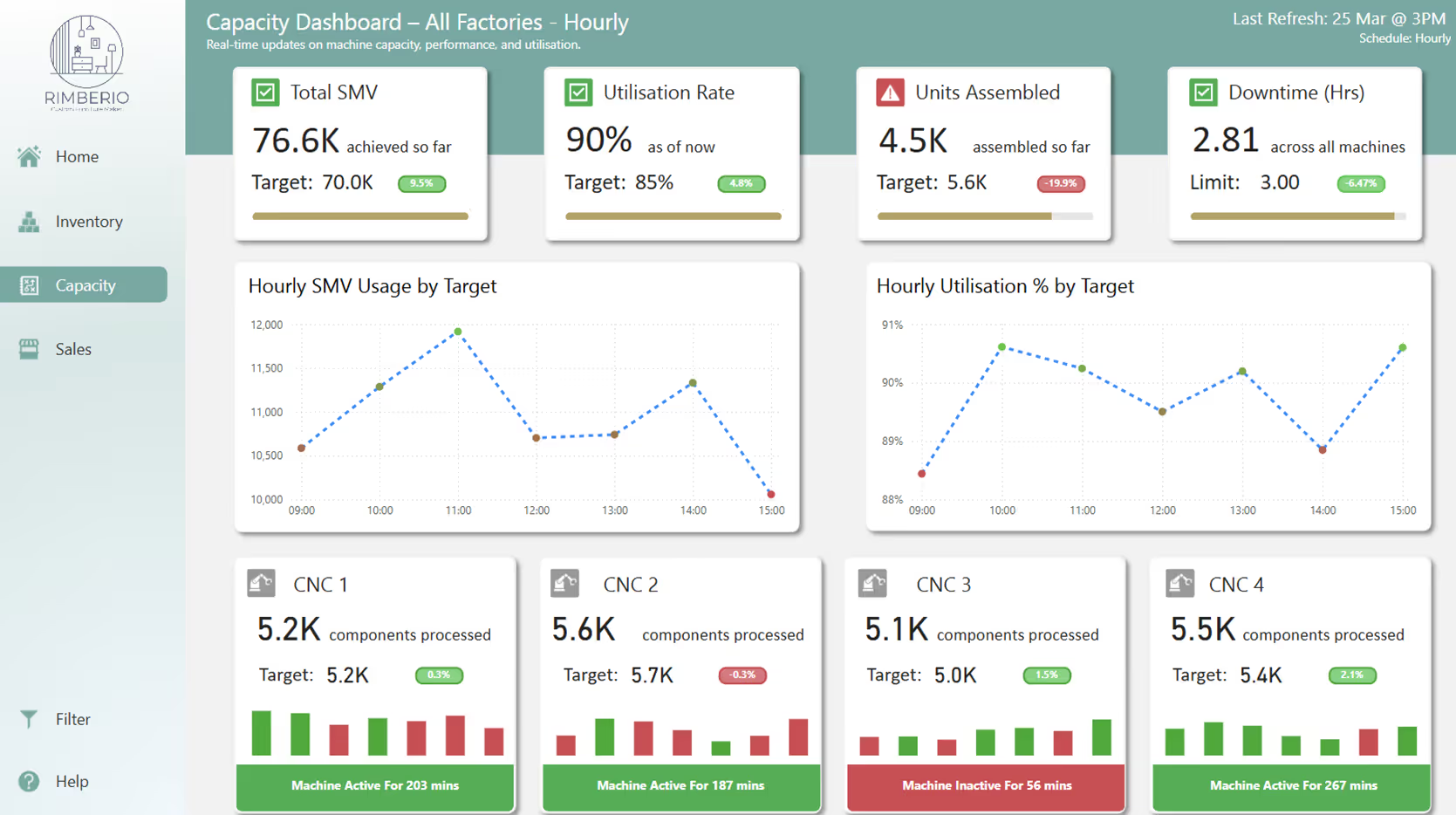
The goal here is to get notified when the number of units assembled reaches or exceeds the daily target of 5,600, ensuring we can track production performance in real-time.
We start by navigating to our Power BI report. The Units Assembled card currently shows 4.5K, which is below the 5.6K target. Since production will increase throughout the day, setting an alert when we hit 5,600 will let us know when we’ve met our goal. To create an alert, hover over the Units Assembled card, click on the three-dot menu (ellipsis), and select "Add alert" from the dropdown.
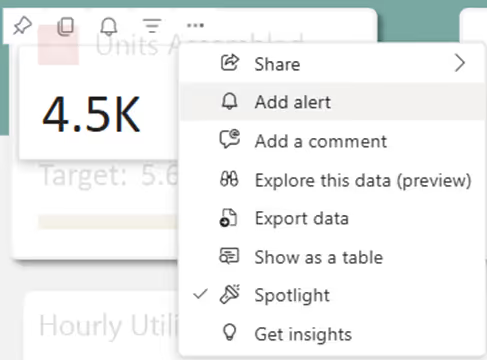
It's important to note, at this point you would receive a message in Teams notifying you that the visual is being monitored and the alert is now active.
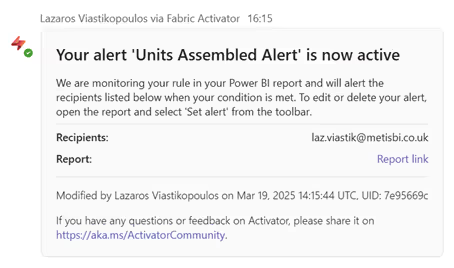
When in the Alerts panel on the right-hand side which you can see below. Here, we configure the following settings:
- Condition: We select "Becomes" and "Greater than or equal to".
- Value: We set it to 5,600, meaning an alert will trigger when the number of units assembled reaches or surpasses this threshold.
- Notification Method: We choose Email, ensuring that key stakeholders are notified as soon as the target is hit. We can also select Teams.
Once configured, clicking Apply activates the alert.
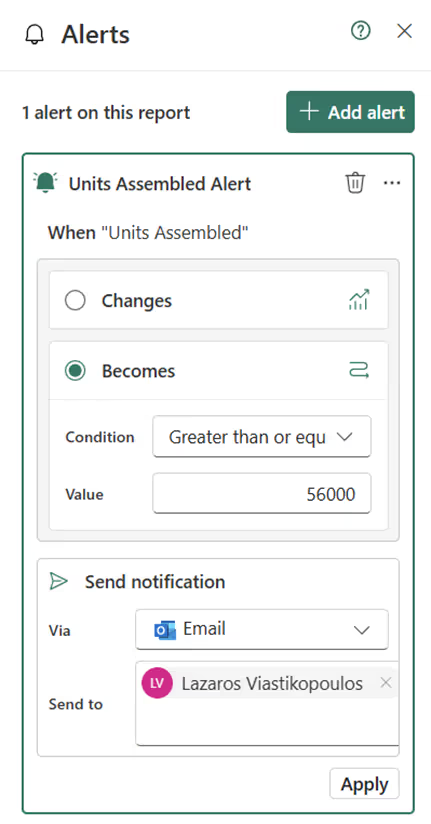
As soon as the number of units assembled reaches 5,600,Power BI sends an email notification.
At the bottom of the Alerts panel, we have "My Power BI Activator Alerts" as you can see in the below screenshot. Let's go ahead and select that.

We now select the appropriate items, as the below:
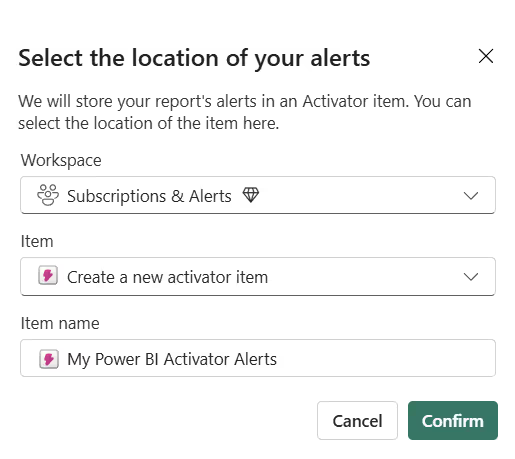
If I see in the workspace, I now have a new item called "Activator":
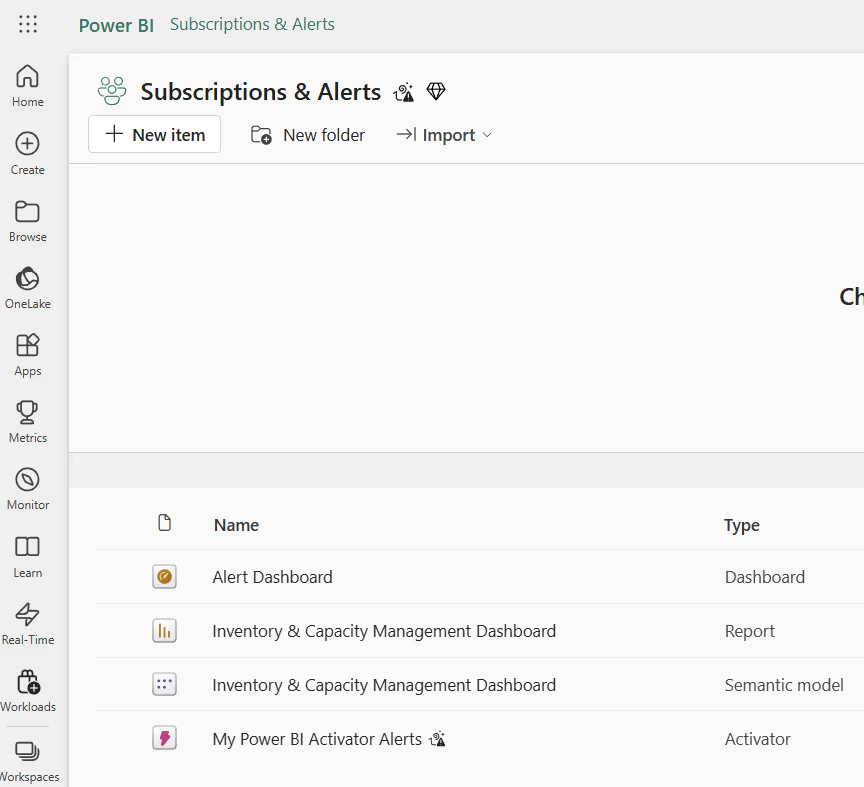
Conclusion
Power BI offers multiple ways to send emails and alerts, whether through standard report subscriptions, dynamic per recipient subscriptions, dashboard tile alerts or Data Activator. Each method serves a different purpose, with subscriptions working best for scheduled reports, while alerts and Data Activator provide real-time notifications based on data changes. While Power BI Alerts are limited to dashboards and numeric values, Data Activator takes things further by enabling automated, event-driven actions for reports, making it a powerful tool for real-time monitoring and notifications.
If you need automated reporting, real-time data alerts or want to explore how Power BI can drive better decision-making for your business, let’s chat! Book a Free Consultation here:
Power BI Help | Free Consultation & Support | Schedule a Call with Metis BI
.avif)




.png)
